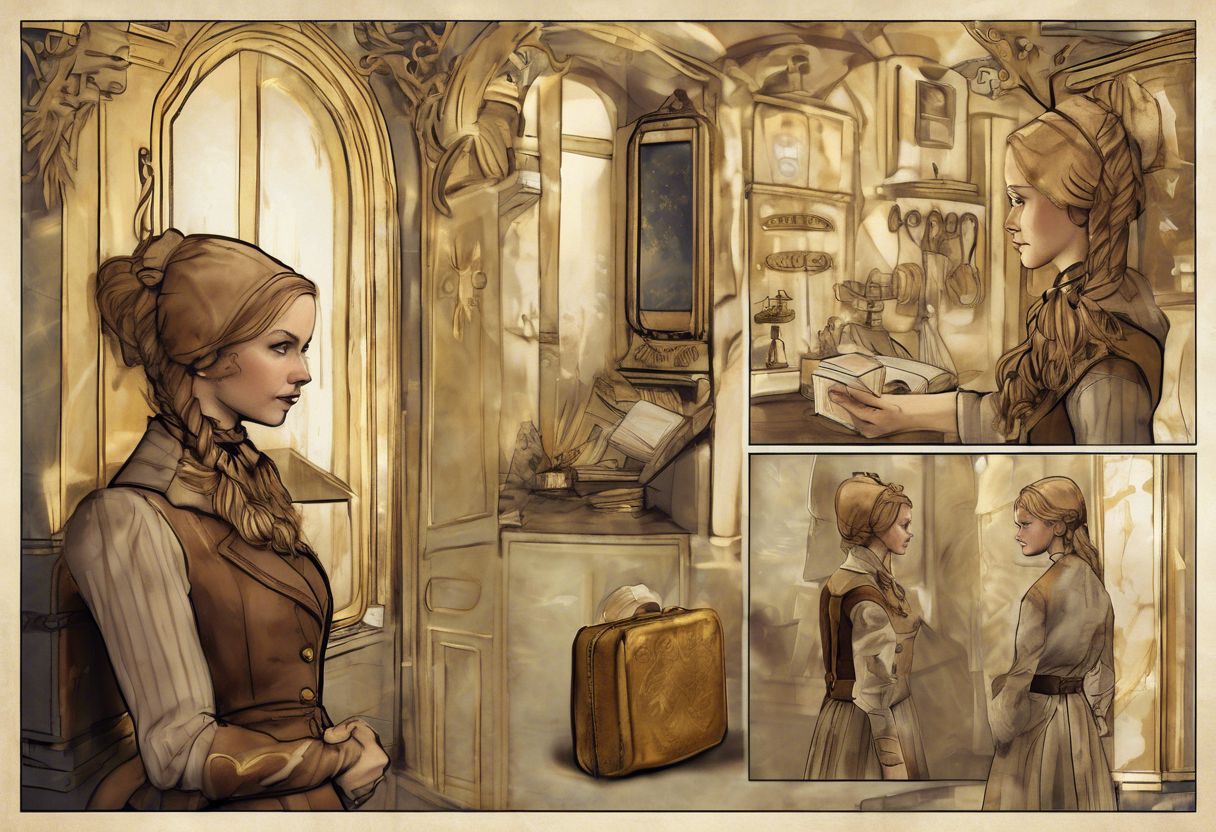Contents
Introduction
Serafina Pekkala stands as one of the most compelling and mysterious figures in Philip Pullman’s The Golden Compass (published as Northern Lights in the UK), the first novel in the His Dark Materials trilogy[3]. As the queen of a northern witch clan, she commands both respect and fascination—not just within her world, but also among readers and critics alike. Her origins are shrouded in the mythos of her people: she is centuries old, yet, akin to the ageless vampires of other fantasy traditions, retains a youthful, ethereal appearance[1]. This semi-immortality, combined with her wisdom and detachment, sets her apart from the human characters and imbues her with an aura that blends the mythical and the authoritative.
Serafina’s backstory is both rich and tragic. She once loved the gyptian elder Farder Coram, and their union produced a son whose death marked both characters profoundly[1]. This personal loss, coupled with her responsibilities as a leader, shapes her worldview and her approach to the events of the narrative. Serafina’s daemon, a grey goose named Kaisa, is notable for its ability to travel independently from her—an extraordinary trait among witches that underscores her supernatural nature and her deep connection to the natural world[2].
Within the narrative of The Golden Compass, Serafina Pekkala is both a seer and a guide. She is one of the first to recognize the cosmic significance of Lyra Belacqua, the novel’s young protagonist, and becomes an early ally in Lyra’s quest to rescue kidnapped children and confront the oppressive forces of the Magisterium[2]. Her role is not merely supportive; she is a catalyst for action, a bridge between the human and supernatural realms, and a living emblem of the series’ broader themes of destiny, free will, and resistance against authoritarianism.
Serafina Pekkala’s significance extends beyond her immediate role in the plot. She embodies a tradition of witch queens in literature—mystical, long-lived women who wield both power and vulnerability. Yet, Pullman’s treatment of her character is distinct, blending familiar archetypes with fresh psychological complexity. Her presence in the story also highlights the series’ feminist undertones, portraying a female leader whose authority is both earned and unchallenged, and whose emotional life is as intricate as her political one.
Role in the Story
Serafina Pekkala’s journey in The Golden Compass is one of quiet but pivotal influence. Though she is not the central protagonist, her actions and decisions reverberate throughout the narrative, shaping the fates of key characters and the trajectory of the plot.
Her first major appearance is through her daemon, Kaisa, who aids Lyra and the gyptians as they journey north to rescue the kidnapped children[2]. Kaisa’s ability to scout and communicate over vast distances is crucial to the success of their mission, and through him, Serafina maintains a presence even when she cannot be physically present. This reflects the unique nature of witches in Lyra’s world, whose daemons can separate from them—a trait that grants them greater freedom and insight than ordinary humans possess.
Serafina’s direct involvement escalates as the stakes rise. She is a key ally in the assault on Bolvangar, the experimental station where children are subjected to the horrifying process of intercision—the severing of the bond between child and daemon. Here, her magical abilities and tactical acumen prove vital, and she becomes a protector not just of Lyra, but of all the children endangered by the Magisterium’s experiments.
Her relationships are as significant as her actions. Her history with Farder Coram is marked by deep affection and mutual respect, yet also by sorrow—their son’s death left an indelible mark on both, and their reunion in the narrative is tinged with melancholy and unresolved longing[1]. This subplot enriches the emotional texture of the story, offering a glimpse into the personal sacrifices demanded by leadership and the weight of centuries-long life.
Serafina also engages in philosophical debates, particularly with Lee Scoresby, the Texan aeronaut. Their conversation about fate and free will is one of the book’s most intellectually engaging moments. Serafina, drawing on her vast experience, argues for a kind of fatalism—she believes that, given enough time, all possibilities recur, and that true choice is an illusion. This perspective contrasts sharply with Lee’s belief in individual agency, creating a dynamic tension that reflects the novel’s larger thematic concerns[1].
Ultimately, Serafina’s role is that of a guide and guardian. She does not seek the spotlight, yet her wisdom, power, and compassion make her indispensable. She is both a participant in and an observer of the central drama, her longevity granting her a unique vantage point on the unfolding events.
Character Analysis
Serafina Pekkala is a character of profound depth, whose personality and motivations are shaped by her extraordinary lifespan, her position of leadership, and her personal losses.
Her most striking trait is her detachment, a quality that arises from her age and experience. Having lived for hundreds of years, Serafina views the world with a perspective that is both panoramic and impersonal. She is not indifferent—far from it—but her emotional responses are tempered by the knowledge that time washes away both joy and sorrow. This detachment allows her to act with a clarity and objectivity that others lack, but it also sets her apart, making her somewhat enigmatic even to her allies[1].
Serafina’s leadership is marked by fairness and wisdom. As queen of her clan, she commands loyalty not through force, but through respect and the earned trust of her people. Her decisions are guided by a sense of duty to her clan and to the greater good, rather than by personal ambition. This selflessness, however, is balanced by a keen awareness of her own limitations and the complexities of the situations she faces.
Motivationally, Serafina is driven by a desire to protect and preserve. Her intervention in Lyra’s quest is not accidental; she recognizes the larger significance of Lyra’s role in the cosmic struggle between freedom and control. Her actions are thus a blend of foresight, compassion, and a sense of responsibility to the future of all worlds.
Yet, Serafina is not without flaws. Her fatalism, while a source of strength, can also be a limitation. Her belief that “every opportunity will come again” can lead to passivity, a reluctance to intervene unless absolutely necessary[1]. This philosophical stance is occasionally at odds with the urgency felt by younger, more impulsive characters like Lyra and Lee. Additionally, her emotional reserve, born of centuries of loss, can make her seem distant or unapproachable.
Her development over the course of the novel is subtle but significant. Initially, she is a remote, almost mythical figure. As the story progresses, however, her humanity becomes more apparent—her care for Lyra, her lingering affection for Farder Coram, and her willingness to risk herself for others reveal a character who, for all her power and age, remains deeply connected to the people and causes she cares about.
Serafina’s relatability lies in this balance between the extraordinary and the familiar. She is a figure of awe and mystery, yet her vulnerabilities, her sense of duty, and her quiet courage make her a compelling and empathetic presence. Readers are invited to admire her, but also to understand the weight of her choices and the loneliness of her position.
Themes and Symbolism
Serafina Pekkala embodies several of The Golden Compass’s central themes and serves as a powerful symbol within the narrative.
One of the most prominent themes she represents is the tension between fate and free will. Serafina’s long life has given her a perspective in which the cycles of history are ever-repeating, and individual choice seems less significant than the larger patterns of the universe[1]. This outlook stands in contrast to characters like Lyra and Lee, who champion the importance of personal agency. Through Serafina, Pullman explores the idea that wisdom can lead to a kind of acceptance of destiny, even as the story ultimately affirms the value of individual action and rebellion.
Serafina also symbolizes the natural world and its rhythms. Her daemon, a grey goose, and her affinity for the northern wilderness position her as a guardian of nature, in harmony with the environment in a way that the more technologically driven factions of the Magisterium are not[2]. Her very existence is a reminder of the beauty and power of the natural order, and her magic is rooted in this connection.
Another key theme embodied by Serafina is the cost of leadership and immortality. Her role as queen is both a privilege and a burden, isolating her from ordinary human experience and forcing her to make decisions that affect countless lives. Her relationship with Farder Coram and the loss of their son illustrate the personal sacrifices demanded by her position, suggesting that true leadership often comes at the price of personal happiness[1].
Serafina’s character also engages with the novel’s critique of authoritarianism. As a leader who rules by consent and respect rather than by force, she offers a counterpoint to the oppressive structures of the Magisterium. Her example suggests that true authority is earned through wisdom, fairness, and a commitment to the welfare of others.
Symbolically, Serafina represents the mystical and the unknown. Her longevity, her magic, and her detachment from mundane concerns mark her as a figure who exists at the margins of the human world, bridging the gap between the ordinary and the extraordinary. In this, she becomes a guide not just for Lyra, but for the reader, inviting us to consider larger questions about the nature of existence, the passage of time, and the meaning of choice.
Cultural Impact
Serafina Pekkala’s cultural impact extends beyond the pages of The Golden Compass. As one of the most memorable characters in the His Dark Materials series, she has captured the imagination of readers around the world and has become a symbol of mystical female leadership in contemporary fantasy literature.
Fans have been drawn to her enigmatic presence, her quiet strength, and her complex emotional life. Online forums, fan fiction, and artistic tributes often highlight her as a favorite character, praising her wisdom, her magical abilities, and her role as a mentor to Lyra. Her relationship with Farder Coram, in particular, has resonated with readers, offering a rare portrayal of mature, bittersweet romance in young adult fiction[1].
Serafina’s portrayal in adaptations has further cemented her cultural significance. In the 2007 film The Golden Compass, she was played by Eva Green, whose performance emphasized both the character’s ethereal quality and her underlying warmth. The BBC/HBO television series His Dark Materials (2019–2022) expanded her role, giving her more screen time and deeper exploration of her backstory and relationships. These adaptations have introduced her to new audiences and reinforced her status as an iconic figure in fantasy media.
Beyond adaptations, Serafina has influenced the portrayal of witches and magical leaders in contemporary literature and popular culture. Her combination of authority, compassion, and vulnerability has become a template for similar characters, challenging the stereotype of the wicked witch and offering a more nuanced archetype. She stands alongside figures like Galadriel from The Lord of the Rings and Minerva McGonagall from Harry Potter as a model of dignified, powerful female leadership.
Serafina’s legacy is also evident in discussions about gender and authority in fantasy. Her unquestioned leadership and the respect she commands from both her clan and other characters serve as a counterpoint to the patriarchal structures depicted elsewhere in the series. In this way, she has become a touchstone for readers and critics interested in representations of women in speculative fiction.
Critical Reception
Serafina Pekkala has been the subject of considerable critical attention, both as a character in her own right and as an embodiment of the themes of The Golden Compass.
Critics have praised Pullman’s creation of a character who is at once mystical and deeply human. Her longevity and supernatural abilities set her apart, but it is her emotional complexity—her sorrow, her sense of duty, her lingering affection for Farder Coram—that makes her relatable[1]. Reviewers have noted that, unlike many fantasy figures, Serafina is neither wholly good nor wholly enigmatic; she is a leader who must balance compassion with pragmatism, and whose decisions are shaped by both her wisdom and her personal history.
Her role in the philosophical debates of the novel has also been a focus of analysis. Scholars have highlighted her exchange with Lee Scoresby as a key moment in the text, illustrating the tension between fate and free will that runs throughout the series[1]. Serafina’s perspective, informed by her centuries of experience, offers a counterpoint to the more immediate, passionate viewpoints of the human characters, enriching the novel’s thematic depth.
Some criticism has focused on the potential limitations of Serafina’s characterization. A few reviewers have argued that her detachment and reserve can make her seem distant, and that her backstory, while poignant, is not as fully developed as that of the central protagonist, Lyra. However, these critiques are often balanced by acknowledgment of the narrative necessity of her role as a guide and ally rather than a main character.
Audience reception has generally been positive, with many readers expressing admiration for Serafina’s strength, mystery, and moral clarity. Her presence in adaptations has only increased her popularity, with actors’ performances bringing additional layers to her portrayal.
Over time, interpretations of Serafina have varied. Some see her as a symbol of unwavering moral authority, while others emphasize her vulnerability and the sacrifices she has made. This multiplicity of readings speaks to the richness of her character and her enduring appeal.
Legacy
Serafina Pekkala’s legacy within fantasy literature and popular culture is both significant and enduring. As a character, she represents a fusion of timeless archetypes—the wise queen, the mystical seer, the compassionate leader—with a modern sensibility that emphasizes emotional depth and moral complexity.
Her appeal lies in her ability to embody both the extraordinary and the relatable. Readers are drawn to her power and wisdom, but also to her vulnerabilities and the personal costs of her choices. In this, she offers a model of leadership that is aspirational yet grounded, suggesting that true authority comes not from force or domination, but from empathy, integrity, and a willingness to bear the burdens of responsibility[1].
Serafina’s influence can be seen in the broader landscape of fantasy fiction, where her archetype has inspired a generation of writers to create female leaders who are nuanced, authoritative, and authentically human. Her presence in the His Dark Materials series has also contributed to the reimagining of witches in contemporary media, moving away from caricature and toward complexity.
In academic and critical circles, Serafina continues to be a subject of discussion and analysis, particularly in studies of gender, authority, and the supernatural in literature. Her role in the philosophical debates of the series ensures her relevance to ongoing conversations about fate, free will, and the nature of choice.
For fans, Serafina Pekkala remains a beloved and iconic figure, a touchstone for those who value wisdom, resilience, and quiet strength in their fictional heroes. Her story—of love, loss, and leadership—resonates across time and culture, ensuring her place in the pantheon of great fantasy characters.
As The Golden Compass and the His Dark Materials series continue to find new readers and audiences, Serafina Pekkala’s legacy will endure, offering inspiration and insight to generations to come.
References
- https://www.shmoop.com/study-guides/golden-compass/serafina-pekkala.html
- https://www.gradesaver.com/the-golden-compass/study-guide/character-list
- https://www.ebsco.com/research-starters/literature-and-writing/his-dark-materials-analysis-major-characters
- https://www.litcharts.com/lit/the-golden-compass/characters
- https://www.litcharts.com/lit/the-golden-compass/characters/serafina-pekkala







